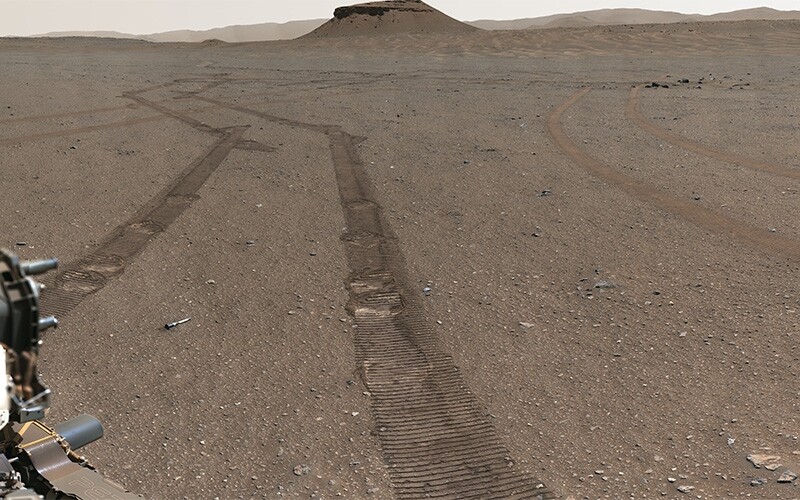
NASA’s Perseverance rover leaves behind a sample tube on Mars that will await retrieval by a helicopter arriving with the future Mars Sample Return mission. (Image credit – NASA / JPL-Caltech / ASU / MSSS)

NASA’s Perseverance rover leaves behind a sample tube on Mars that will await retrieval by a helicopter arriving with the future Mars Sample Return mission. (Image credit – NASA / JPL-Caltech / ASU / MSSS)
Costs are rising for Mars Sample Return, a mission to retrieve rock and soil that the Perseverance rover is collecting in the former lakebed of Jezero Crater so that it can be analyzed in laboratories on Earth.
The samples should provide unprecedented insight into Mars’ geological history and could even reveal evidence of past life. But the price is steep: NASA is poised to spend well over $5 billion on MSR and the mission is starting to pull funding from other efforts.
While agency leaders are calling for unity in the face of such developments, some members of the science community have been asking probing questions about MSR, and some lawmakers are starting to voice discontent as well.
Last year, NASA cited MSR’s funding needs
NASA Science Mission Directorate head Nicky Fox acknowledged at an online “town hall” meeting
At a another town hall
Notwithstanding NASA’s point of view, MSR’s demands, alongside the postponement of the VERITAS Venus probe following a delay
At the hearing on NASA’s budget
House Science Committee Chair Frank Lucas (R-OK) likewise flagged MSR’s cost growth
MSR is a multi-vehicle project that NASA is pursuing in partnership with the European Space Agency, and its emergence as a behemoth in NASA’s science mission portfolio has been sudden. As recently as 2020, it did not have a dedicated budget line.
That year, while MSR was still in its earliest planning stage, NASA convened an independent review board to obtain an outside perspective on it. Reporting back, the board concluded
Subsequently, NASA and Congress raised the mission’s annual budget from an initial $242 million in fiscal year 2021 to $822 million this year, cumulatively providing $1.7 billion to date. This unusually aggressive push received important backing last year, when the National Academies’ latest planetary science decadal survey ranked it the highest-priority project for NASA this decade
However, estimating that MSR would have a full lifecycle cost of $5.3 billion, the survey also warned the mission could unbalance NASA’s planetary science portfolio. It recommended MSR claim no more than 35% of the portfolio budget in any given year and that its total cost not exceed the survey’s estimate by more than about 20%. Should either threshold be breached, the survey recommended NASA “work with the administration and Congress to secure a budget augmentation to ensure the success of this strategic mission.”

NASA Administrator Bill Nelson testifies before Senate appropriators on April 18. (Image credit – Bill Ingalls / NASA)
It is clear that early cost estimates for MSR will prove too optimistic, though by how much remains uncertain. NASA has not released internal estimates, but its latest budget request presents a notional budget profile
MSR Program Director Jeff Gramling addressed
Such pressures may be squeezing MSR’s near-term budgets as well as driving up its overall cost. NASA Planetary Science Division Director Lori Glaze said at a National Academies meeting
For the moment, MSR is within that limit. NASA is seeking $950 million for the mission in fiscal year 2024, which is 28% of the requested planetary science budget. However, NASA Administrator Bill Nelson recounted at the Senate budget hearing that on a recent visit to the Jet Propulsion Laboratory, which is developing MSR, he was told it needs more money.
“They’re saying they want another $250 million in this year — meaning in this year, the existing 2023 — and 2024,” Nelson remarked.
Contacted by FYI, a NASA spokesperson refrained from clarifying whether Nelson meant JPL wanted $250 million above the request for fiscal year 2024, which begins Oct. 1, or a total of $500 million across fiscal years 2023 and 2024. The spokesperson said the cited amount was not “official,” but rather “illustrative of supply-chain challenges with this and other NASA major projects,” and that the agency’s 2024 request remains unchanged.
Pressed by Sen. Jeanne Shaheen (D-NH), the Senate’s lead appropriator for NASA, on how MSR’s costs can be controlled, Nelson replied, “Some of those costs are not going to be avoided and we’re going to have to make choices.” He said, unless Congress allocates more funding on its own accord, his options include stretching the mission’s schedule and reallocating money from other science missions.

An illustration of the current vehicle architecture for the Mars Sample Return mission. From left: one of two sample-retrieval helicopters, the Perseverance rover already on Mars, an ESA-built orbiter that will transport samples back to Earth, a lander, and an ascent vehicle. (Image credit – NASA / JPL-Caltech)
In the past, NASA officials have denied
Applying that policy may not be straightforward with MSR, though. The 2020 independent review observed that MSR’s mission architecture is tightly focused on sample return with little room for trimming capabilities. In addition, it deemed 2028 to be MSR’s last “viable” launch date because the next opportunity, in 2030, presented unfavorable conditions for Mars arrival.
Another issue is that last year NASA made major changes
The new plan disposes of a “fetch” rover ESA was to provide. Instead, Perseverance will deliver 30 sample tubes to MSR’s ascent vehicle itself. In case Perseverance cannot do so, the mission will carry two helicopters to retrieve 10 backup tubes Perseverance has already left at a “depot,” though NASA has indicated it might eliminate one helicopter to control costs.
To update the 2020 review, NASA is currently setting up
NASA aims to commit to a baseline design, cost, and schedule for MSR late this year.